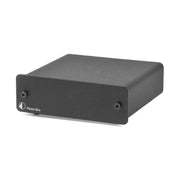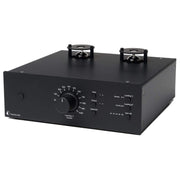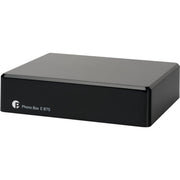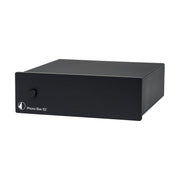In the late 90’s I was given my first vinyl record from my local music store. I had no method to play the record and a complete lack of experience with vinyl. I went a to a local electronics store and purchased a $100 turntable. Plug and play, it went into any system on any input and did the job that I expected with my lack of understanding and also lack of quality equipment. It was not until I decided it was time to upgrade the glorified boombox sound system I had to something with more depth, power and function that I suddenly got confused. I realised I had no idea about the function and requirements to truly experience vinyl and record players.
Jump to the present day and vinyl is now one of the leading mediums of audio reproduction and music sales, with origins from the original seven-inch record in the 19th century to the now 12-inch record that can come in all matter of forms and quality. With such a resurgence and growing following of vinyl loyalists, the market has grown and expanded in ways many assumed would have been crushed by the introduction of modern media formats.
The phono pre-amplifier, also known as the phono stage, it could be considered the most important part of the vinyl playback experience and in my experience it is. Understanding this is the fundamental basis and beginning to a complex but brilliantly satisfying record experience. The path will be so different to everyone based on their ears, systems and expected use. For the purposes of this article and the fact the phono signal is dealt with in a unique way, phono stage will be how I refer to the audio source.

Pro-Ject Phono Box Phono Preamplifier

Pro-Ject Tube Box DS2 Tube Phono Pre-amplifier

Pro-Ject Phono Box E BT5 Phono Preamplifier with Bluetooth Transmitter

Pro-Ject Phono Box S2 Phono Pre-amplifier
What is a phono stage?
A phono stage is pathway of circuitry that takes the minute level (very low voltage) and negative style of a records audio information and outputs it in a manner that the playback can connect to any system and be understood to resemble what the musician intended the listener to hear. It is an amplifier for a phono signal generated by the stylus of the cartridge on your turntable’s tonearm.
Phono stages come in many forms, shapes, sizes and functions as the variables are endless, but they all have one thing in common, the RIAA curve. The RIAA curve is an equalisation process that maintains the audio playback at a standard as expected by the master recording of the audio. Recording Industry Association of America, RIAA, has been a global standard since the 1950s, and before this individual record manufacturers had used their own standards for controlling the augmentation and control of the audio frequency spectrum coming from the grooves on the records. Mastering and production of records is a story in itself, without a phono stage and the RIAA curve, audio playback would be backwards to say the least and quite likely impossible to hear as the output level is so small and missing the attenuation required to reproduce the audio that has been mastered on to the record.
What is best for you?
When it comes to selecting a Phono stage/phono amplification path, the most important aspect is determining what cartridge or cartridges you intend to use in your system. The most common types are Moving Magnet (MM) and Moving Coil (MC). MC comes with a vast range of variables which is determined by the particular properties of the cartridge. By matching the variables with the phono stage to the cartridge being used, you ensure the best audio performance of the setup as expected by the manufacturers. In some cases, particular older MC cartridges, some producers of audio equipment made “line boosters” to attenuate and increase the amplification often for a specific cartridge on top of have a phono stage. This is not as common these days as most units these days can do this.
This is where the selection process can get tricky, what deems the best setup for an individual system? It is determined by what you have and how you plan to progress in your journey to your audio nirvana, honestly meaning it can be very difficult initially but with some common ideas and simple understandings the outcomes can be improved. If you are one who enjoys playing around with your system and sound, leading to multiple cartridges and multiple turntables, it is best to understand the phono stage fully before you purchase as they are not all created equal.
Integrated phono stages are often a simple yet effective means for a simple setup, with most cases the variables are fixed and the build quality is not comparable to an external phono stage. The complexity and sensitivity of such a signal is prone to electronic noise in an integrated system. Tiny variation in such a low voltage signal is more amplified than say that of “normal” line signal from another source, leading to poor audio output with unwanted noise from the record. A common case with an integrated phono stage, the ability to use different cartridges or different turntables with different setups is not supported. With this is mind, the path to future proof most systems is with an external phono stage.
An external phono stage has ability to come in every form, from simple phono signal amplifier to headphone amplifier with a DAC onboard to digitally record your priceless records. The structure and function are literally endless when it comes to selection of an external phono stage. The benefits for that in most cases and depending on the money you want to spend, you can find a perfect match for now and the future of your system. By having an independent device, not only is it often built with better quality components but has a dedicated and clean power supply to reduce the noise floor of the equipment at a massive advantage. The ability to adjust a signal path, especially with MC signals, can come as a simple knob on the front down to opening of the actual device and adjusting the components on the internal PCB board as per the manufacturer’s instructions and often done by the reseller or manufacturer themselves.
Key things to note and look for in a phono stage:
- MM/MC support or both
- Attenuation/Volume Control/Fixed Output
- Signal Path Variability
- Onboard DAC or recording feature
- Simple form and function – Knobs vs Switches or PCB Board adjustments
- Power Supply
- Multiple inputs for multiple Turntables
Points to consider for your personal selection is a big decision
- Do you plan on changing cartridges?
- Will you want to upgrade the Phono RCA cable from the often-supplied simple cable?
- Will you upgrade the cartridge cables?
- Will you upgrade the Tonearm?
- Will you have multiple turntables?
- Will you listen to 33, 44 and 78s?
I personally find especially for myself and a lot of people I share the love of records and turntables with that the addiction is intoxicating. And if you are one to really dig into a hobby and music reproduction is fun and important to you, I cannot say how important it is to get the best phono stage you can firstly. All else that follows will fall into place and grow as you grow with the vinyl medium. For my own system, it was seven years with many different options, integrated and externals. I have two external phono stages, one for the purposes of being my dedicated phono amplification path and another which allows me to listen to records directly with headphones or record directly to my PC.
By no means are all phono stages created equally, and often price my represent function over quality, for instance headphone out and DAC vs a purely dedicated phono stage made to simply provide a pure function. What suits you will not suit everyone else, but thankfully it is rarely an issue as there is such a huge selection out there. You are almost guaranteed to find the phono amplification path to suit any system and personal needs. Nostalgia or just for the ability to play the crate of records you have had for years, it is a brilliant means to music and a very social side to music I have personally not experienced with any other medium of audio. Whether it is your main source of music or just that to bring out the 1970s turntable and have a blast, Enjoy!







